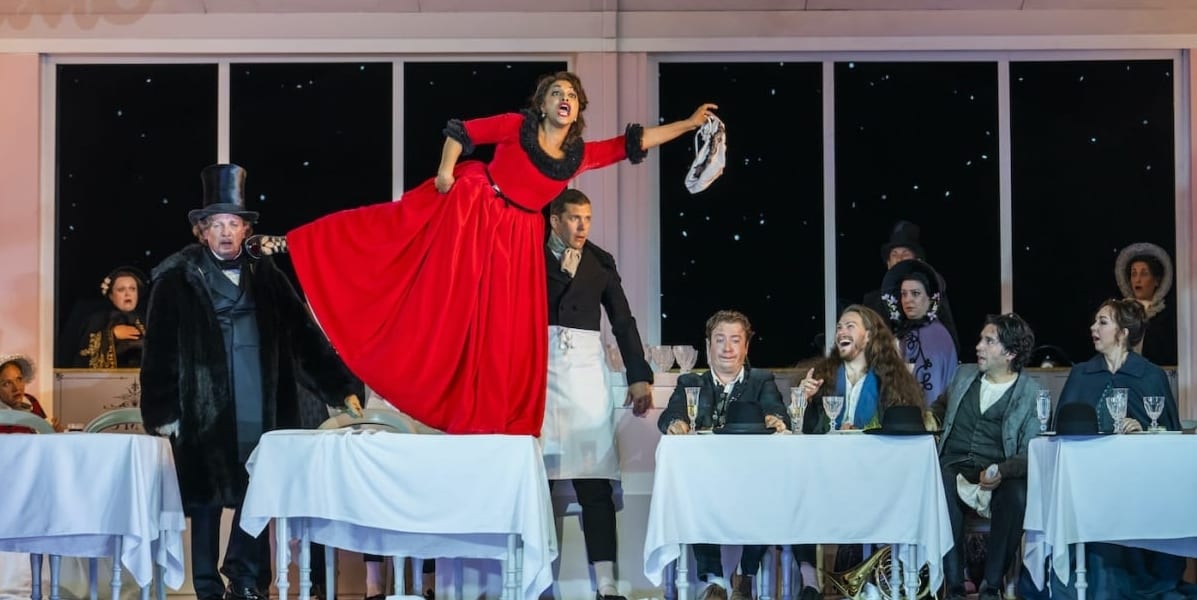Richard Jones’s production of La bohème has become the poster child of London’s Covent Garden. Studded with festive tropes of Parisian fantasy: falling snow, bustling market squares, and most urgently fractious lovers, Jones’s aesthetic paints an irresistible vignette of the past. As ever with opera, though, the artform’s beauty—in this case, the production’s spectacle—is underpinned by the narrative’s realist tragedy. Puccini’s opera, after Henri Murger’s 1851 novel, traces the life of the TB-stricken seamstress Mimì, whose demise is not too dissimilar to the devastating realities the world is dealing with at present.
To match these uncertain times, Jones’s production was granted a COVID-safe revamp under the meticulous care of production manager Cliona ni Mhocháin, and stage manager Jo Holmes. Spearheaded by director Dan Doomer, adaptations were accounted for from rehearsals to orchestral size—though, reductions didn’t necessarily equate to artistic compromise. The performance stayed true to the house’s reputation of quality performances, with a cast of admirable voices. Soprano Anna Princeva’s performance of Mimì captured the role’s delicacy and later frailty. Princeva’s vocal prowess was at its most luminous in the opera’s famed Act I aria “Si, mi chiamano Mimì”. Her poetic counterpart, Rodolfo, was matched by tenor Joshua Guerrero, whose lyrical phrasing and sensitive acting accentuated an already compelling performance. At times, however, Guerrero’s attention to expression led to taking some liberties with the notated rhythm.
As for the surrounding troop of bohemians, Boris Pinkhasovich’s Marcello was assured, lyrical, and devastatingly compelling. The Act III interaction preceding Mimi’s heart-rendering “Ah, Buon Marcello” was demonstrative of the baritone’s faculty. Similarly, the unapologetic role of Musetta—Marcello’s ever-quarreling ex—was executed brilliantly by Danielle de Niese. Moments of florid coloratura were reeled off effortlessly by the soprano. Characterised by audacious gestures, in this production Musetta is to seize the attention of polite society through scandal, and de Niese’s balance of playful and coy certainly met the agenda. Other moments of note were realised through Cody Quattlebaum’s Schaunard, whose sense of camaraderie amongst the group was thoughtful, as was Gianluca Burratto’s Colline in the apostrophising aria to his jacket, “Vecchia zimarra”.
Since restrictions have meant the usual orchestral and chorus forces must be reduced, both conductor Renato Balsadonna and chorus master William Spaulding have worked to honour the score as best possible. The Orchestra of the Royal Opera House was well balanced, attentive to the singers, and Balsadonna teased out Puccinian colour with ease. Of the usual 74 players in the pit, only 47 were permitted, and wind sections were reorchestrated by Mario Parenti. Similarly, Spaulding’s efforts to maintain the fizz of the charming Act II children’s chorus did not go amiss: 10 children were cast from the same school in order to maintain a safe “social bubble”, and the usual energy abounded.
At a time where arts funding and live performances are particularly tenuous, it is more crucial than ever to support cultural institutions. These online streams are one of many accessible schemes the Royal Opera has provided over the course of this pandemic, and until live performances become second nature again, enjoying opera—at affordable prices from home —is sure to keep music lovers afloat.

